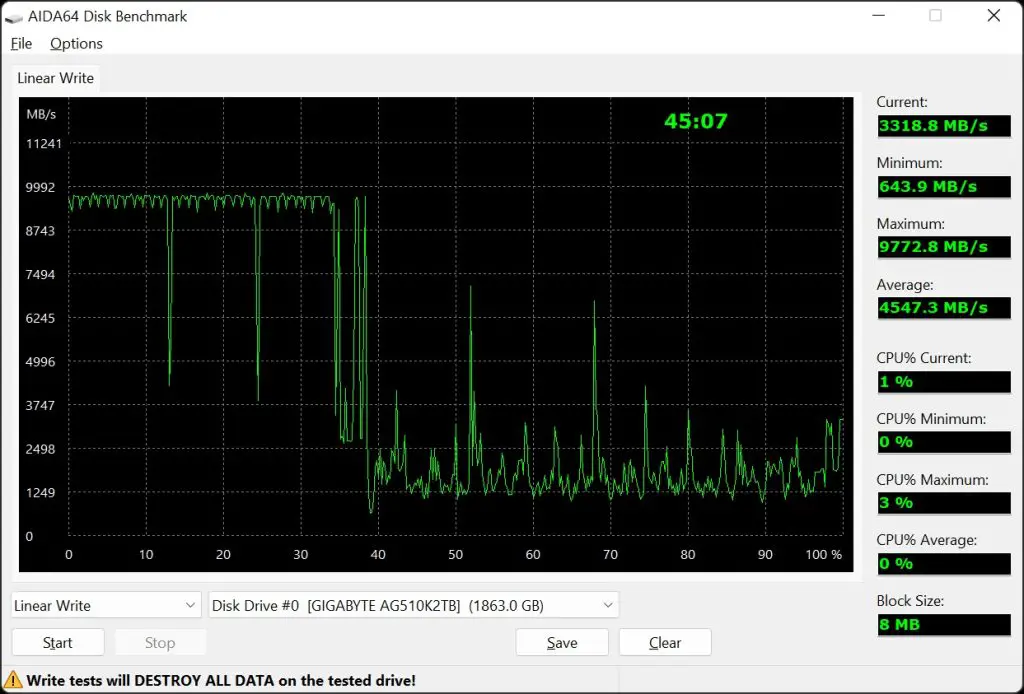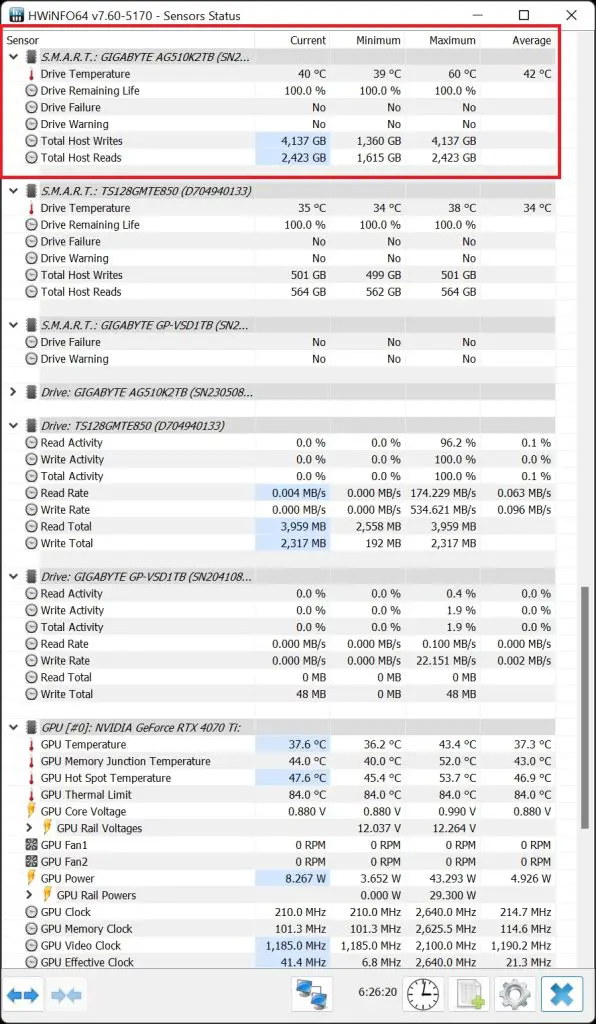It’s been quite some time since we heard of PCIe 5.0 storage but despite the bold claims on the blazing-fast transfer speed over the previous-gen design, we never really get to see much of it – at least, not until now. AORUS reached out to us with their AORUS Gen5 10000 SSD 2TB this time, so we’ll be taking a look at what kind of performance we can expect from this SSD and if it can hold up to the heat which PCIe 5.0 SSD controllers are infamous for.
Specifications
| Product | 1TB | 2TB |
| Pricing | N/A | N/A |
| Form Factor | M.2 2280 | M.2 2280 |
| Interface / Protocol | PCIe 5.0 x4 | PCIe 5.0 x4 |
| Controller | Phison E26 | Phison E26 |
| DRAM | LPDDR4 | LPDDR4 |
| Flash Memory | 232-Layer Micron TLC | 232-Layer Micron TLC |
| Sequential Read | 9,500 MBps | 10,000 MBps |
| Sequential Write | 8,500 MBps | 9,500 MBps |
| Random Read | N/A | N/A |
| Random Write | N/A | N/A |
| Security | N/A | N/A |
| Endurance (TBW) | 700TB | 1,400TB |
| Warranty | 5-Year | 5-Year |
Unboxing
This slideshow requires JavaScript.
The AORUS Gen5 10000 SSD 2TB ships in a simple and clean package similar to its predecessor, the AORUS NVMe Gen4 SSD 2TB. Though, unlike the PCIe 4.0 model, the AORUS Gen5 10000 SSD comes with a much more sophisticated heatsink with heat pipes and fins array for better heat dissipation as compared to a block of Copper heatsink.
This slideshow requires JavaScript.
From the design, we can see that it actually has the same design as the VRM heatsink used on the enthusiasts grade AORUS motherboard i.e AORUS Master and Xtreme, which is known for its good heat dissipating performance. There’s a total of two heat pipes on the heatsink that is in direct contact with the SSD, which will direct the heat to the fins array that is coated with what AORUS claims to be ‘Nanocarbon coating’ to improve the heat dissipation.
The SSD, on the other hand, features the Phison PS5026-E26 controller capable of 10,000MB/s sequential read and write performance, 2GB worth of LPDDR4 cache, and the 232-Layer TLC NAND chips from Micron. As of now, it only comes with two capacities of 1TB and 2TB, with sequential read performance of up to 9,500MB/s and 10,000MB/s respectively.
Benchmarks
For the benchmark, we’ve tested the AORUS Gen5 10000 SSD 2TB using the following specs to eliminate any potential bottleneck:
| CPU | Intel Core i9-13900K |
| Motherboard | ASUS ROG Maximus Z790 APEX |
| Memory | ADATA XPG LANCER RGB DDR5@6000MHz CL30 (16GB x2) |
| Graphics Card | Gigabyte GeForce RTX 4060 Ti Gaming OC 16G |
| Power Supply | Cooler Master M2000 Platinum |
| Primary Storage | Kingston KC3000 2TB |
| CPU Cooler | Cooler MasterLiquid PL360 Flux |
| Chassis | Cooler Master MasterFrame 700 |
| Operating System | Windows 11 Pro 64-bit 21H2 (Build 22000.1696) |
We’ve gathered the performance data using commonly used tools like CrystalDIskMark, ATTO Disk Benchmark, and AS SSD Benchmark for the base performance numbers as shown below。
This slideshow requires JavaScript.
From the data, we can see that the AORUS Gen5 10000 SSD 2TB can indeed reach an impressive performance of up to 10,000MB/s on both the sequential read and write performance, slightly better than what is listed on the official specifications.

As for the linear write test using AIDA64, we can see that although the SSD is capable of reaching up to 9772.8MB/s write performance, the performance started to plummet at the 40% mark of the test progress, which indicates the cache is already filled up to the max. Though there are signs of cache clearing throughout the remaining tests, which gives the SSD an average performance of 4547.3MB/s as a result.

Despite the impressive performance, the main concern is still the temperature because we’ve seen how PCIe 5.0 SSD controller heats up rapidly during heavy write performance and can easily hit 80°C in just a matter of seconds. The AORUS Gen5 10000 SSD, shows a maximum temperature of only 60°C, which is actually good because the SSD can maintain its best performance without any thermal throttling at this temperature.
Should you buy the AORUS Gen5 10000 SSD?
For the price of RM 729 and RM 1599 for the 1TB and 2TB models, the price of the AORUS Gen5 10000 SSD is just like what we can see back then when the AORUS NVMe Gen4 SSD 2TB was first launched. It’s not cheap for sure but looking at the performance numbers, I’d say yes but only if you really need this kind of performance and you have the hardware that actually supports it.
Normal users and gamers don’t really need sequential read and write performance at 10,000MB/s as it’s almost impossible for normal usage or even gaming to be able to even utilize half of that. Content creators that work on heavy rendering and need the fastest possible storage to speed up their work are the group of users that I think will benefit from what the AORUS Gen5 10000 SSD can deliver.









